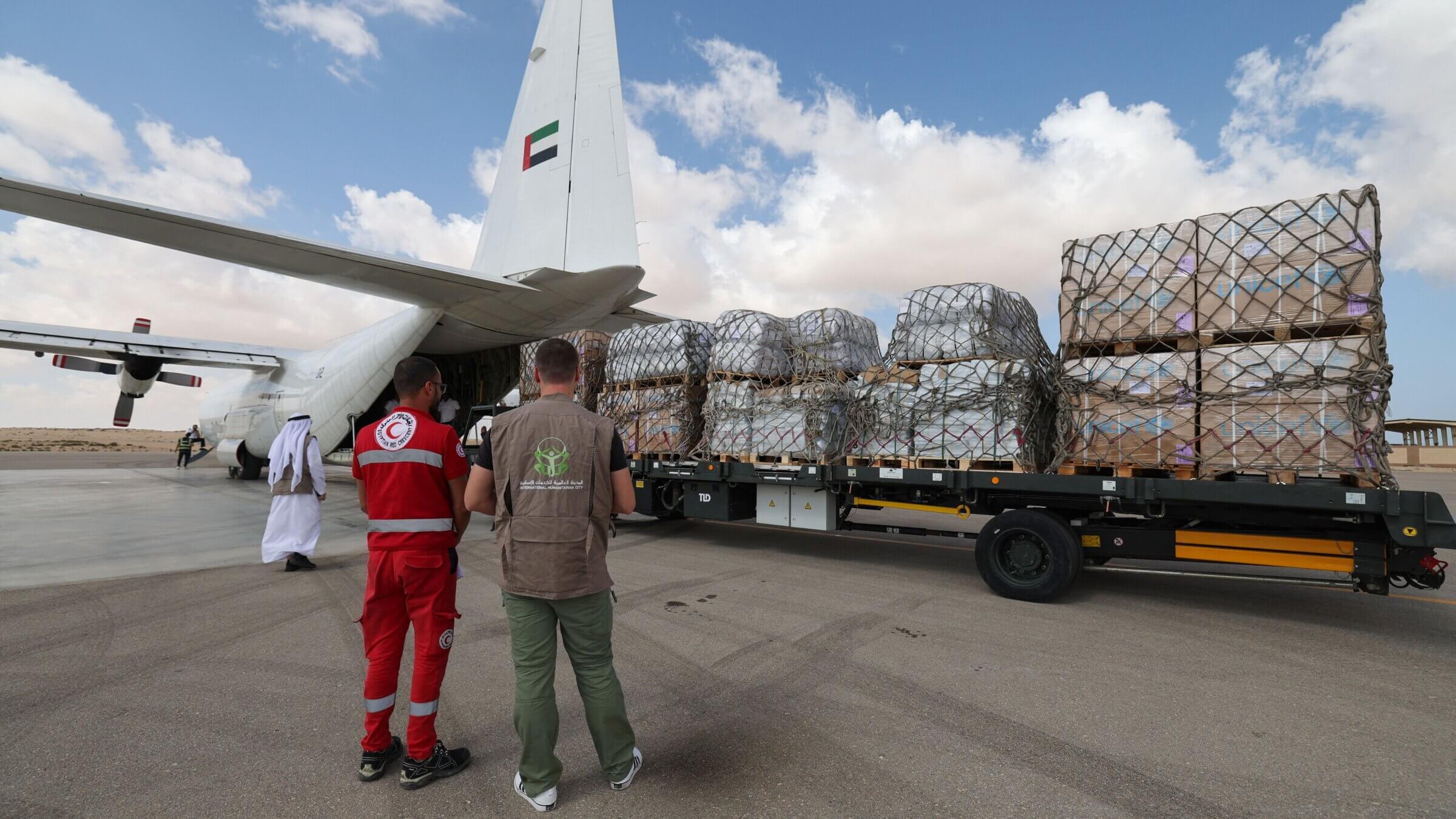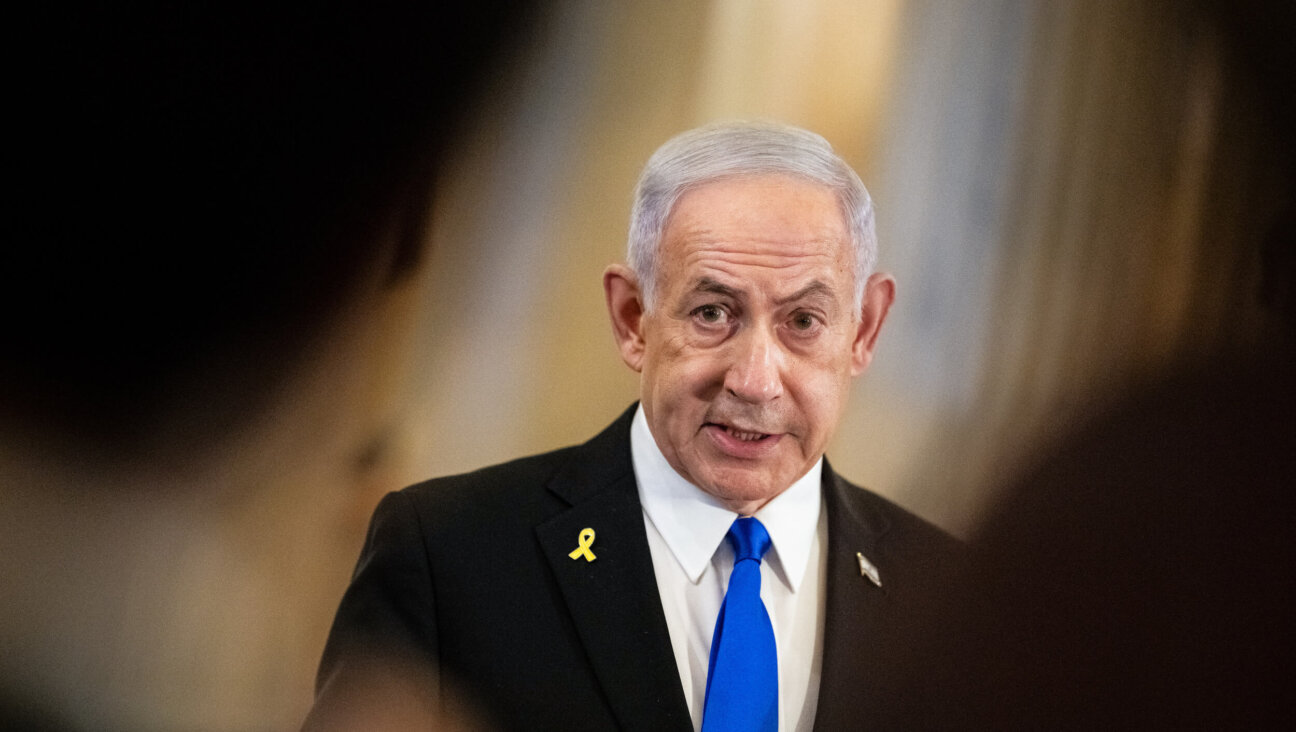Gazans are starving. Airdrops of aid could help change that
Aerial food drops over Gaza could help prevent a famine while bypassing security and distribution challenges

Staff members unload aid for the Gaza Strip from an Emirates cargo plane on the tarmac of Egypt’s el-Arish airport in the north Sinai Peninsula on Oct. 19. Photo by Giuseppe Cacace/AFP via Getty Images
Since the horrific events of Oct. 7 and the ensuing Israeli war, conditions inside the Gaza Strip have become increasingly dire. Many residents now face hunger and starvation, and spend hours each day searching in vain for drinkable water and scraps of food.
My brother’s wife and four young children, along with other friends and family members, have lost significant amounts of weight. Many Gazans are barely surviving. A recent U.N. report found that 93% of Gazans are experiencing crisis levels of food insecurity, and predicts that conditions could constitute a famine as soon as February.
Fresh produce, meat, canned goods and nutrient-dense foods are hard to find and have quadrupled in price. The financial system has largely collapsed, making it difficult for people to withdraw money or receive support from abroad.
This crisis is unprecedented, and so should be the international response. We must act quickly — and smartly — to save lives. Thankfully, we have the tools to do so in a way that has broad international support: distribute humanitarian aid through airdrops. The United Nations, United States, Europe and Arab countries, in coordination with the IDF, should rapidly coordinate airdrops over Gaza to deliver desperately needed food to civilians who are starving.
How aid gets to Gaza
Before the current war, Gaza relied heavily on Israel to facilitate the import of food and other humanitarian supplies. However, Israel’s War Cabinet made the decision to halt all deliveries of food, water, electricity and fuel to the Gaza Strip immediately upon initiating the counteroffensive, leading to a rapid rise in the levels of hunger.
Israel has allowed some aid to enter the Gaza Strip since late October. However, such deliveries have been woefully inadequate to meet the urgent and immensely growing needs of a desperate population.
Aerial food drops, on the other hand, could deliver much more aid and bypass the interference and theft from nefarious players such as Hamas. Such airdrops, containing foodstuffs like flour, rice, powdered milk, and legumes, could help saturate Gaza with food and prevent the onset of famine.
While it might sound like a wild idea, there is a successful precedent for this sort of coordinated campaign. In 2020 over South Sudan, for example, the U.N. filled large cargo aircraft with hundreds of reinforced food bags containing grains that were easily dropped from the back of airplanes without the need for parachutes.
Two days ago, the French and Jordanian air forces jointly airdropped medical aid over Gaza, in coordination with the IDF. This operation, which went off without a hitch, sets an important precedent and confirms the viability of this option. The success, it should be noted, required the airspace above the area and the ground below to be kept free of fighting for the duration.
Of course, many simultaneous drops would be needed for food airdrops to meet the massive unmet needs of Gaza’s civilians. And aerial drops are not a realistic long-term option. However, they can be effective in rapidly getting desperately needed supplies to the war-torn Strip, so that they can be immediately obtained and used.
Logistics and distribution challenges
The U.N. and aid groups on one hand, and Israel on the other, trade blame for why adequate food aid is not currently reaching Gaza’s hungry civilians. Israel says that the U.N. has inflexible logistics systems. It contends that UNRWA, tasked with administering U.N. services in the Palestinian territories, is failing to bring in and distribute aid effectively because the agency continues to use inflexible pre-war mechanisms which don’t meet the current overwhelming needs.
Israel’s defense body responsible for civilian affairs in Gaza, the Coordinator for Government Activities in the Territories, also claims that Israeli authorities are capable of inspecting significantly higher numbers of aid trucks, but that the U.N. and international community are not sending enough aid. The U.N. has repeatedly pushed back on this, saying that distribution is immensely difficult because of damaged infrastructure and is dangerous under combat conditions, which have regularly gotten aid workers killed.
Inspection mechanisms for checking trucks going into Gaza have likewise caused delays in processing the hundreds of trucks awaiting permission to enter the Strip. Trucks carrying aid to Gaza are inspected by the Israeli and sometimes Egyptian authorities, a process during which trucks often line up for miles and wait for days before being allowed into Gaza. And once they do make it in, the ferocious IDF operations — not to mention the challenging breakdown of social order, proliferation of crime and chaos and interference from Hamas — make safe and effective distribution almost impossible. And given that most of the aid is distributed in southern Gaza, an estimated 200,000 Gazans trapped in the north are unable to access any of it.
Desperate civilian mobs regularly attack trucks carrying aid, looting some of their contents before they reach warehouses or designated distribution centers. There are also videos that show armed gunmen in civilian clothing on top of aid trucks, usually Hamas policemen seeking to protect aid convoys from civilian mobs and from organized criminals who aim to resell the goods on the black market. But Hamas does also have sophisticated ways of covertly siphoning off significant quantities of aid meant for civilians for their fighters.
Due to all of these challenges, Gaza’s civilian population continues to face unprecedented levels of hunger. Aid that is inadequate to begin with is hardly reaching those who need it the most.
A model of successful humanitarian air operations
The U.N., especially the World Food Program, has vast experience with humanitarian air operations throughout the world, particularly in Africa, where it has conducted large-scale food drops for decades.
This expertise should be applied to the current situation in Gaza as well. The few recent drops organized in coordination with the IDF and Jordanian air force have provided a model for how to navigate the complex battle space in Gaza, demonstrating the IDF’s willingness to coordinate the aerial delivery of humanitarian supplies if done in a safe, secure and coordinated manner. Additional IDF-approved food airdrops could be done by partnering with the U.N. Humanitarian Air Service and other interested countries.
Saturating the Gaza Strip with food aid could help stave off the worst of the hunger wave and ensure that it does not develop into a full-fledged famine. Most importantly, Hamas and other nefarious parties will have less of an opportunity to intercept aid that is dropped directly in civilian areas throughout Gaza, unlike aid delivered by truck. These airdrops should happen throughout the day when people are out and about looking for food, and should take place at random times to avoid creating a predictable pattern that can be exploited by bad actors. They should also, of course, take steps to ensure that heavy items, like heavy flour bags and food crates, are delivered in a way that minimizes the risk of injury to people on the ground.
It is inevitable that some of the aid will be taken, and maybe even hoarded, by Hamas members and other insurgent groups. But feeding starving civilians is well worth this risk. Gazans are a tight-knit community, and those with more food will likely share with friends, family and neighbors who are in need.
If the IDF is determined to screen the contents of the airdrops, they have several bases near Gaza — and Egypt has suitable airports in the northern Sinai — that could be used to inspect aid and as staging areas for humanitarian airdrops. From technical and security points of view, no challenge is insurmountable or incapable of being addressed to make this viable, palatable, practical and achievable.
A win-win for all
While endorsing food drops should be a no-brainer and is anecdotally widely supported, I have received some opposition and doubts from pro-Palestine activists who decry my calls for the IDF to be involved in addressing a hunger crisis that they feel strongly was caused by deliberate Israeli policies in the first place.
But any meaningful action to help Gazans must absolutely be in coordination with Israel, even if one vehemently disagrees with the IDF operation and opposes its policies toward the coastal enclave, as I do. What some may view as naïveté might just be the only hope we have to stop the onset of a fast-approaching famine that will forever decimate the Palestinian civilian population in Gaza. I have lost dozens of family members and both of my childhood homes to Israeli airstrikes. And even so, working with Israel is an inevitable necessity to implement desperately needed measures that solve specific problems.
Israel regularly states that it is not blocking aid delivery to Gaza, and that if its legitimate security needs are met, virtually nothing is off the table to increase the amount of aid and food deliveries to civilians in the Strip.
The food airdrops proposal takes that to heart, and builds upon it. There is a viable opportunity to work with Israel’s own statements and do this in a way that is a win-win for all: Gaza’s starving children and civilians, Israel’s need to avoid a famine on its southern borders, aid agencies, the international community, and the humanitarian conscience of a deeply troubled world.
To contact the author, email [email protected].


















